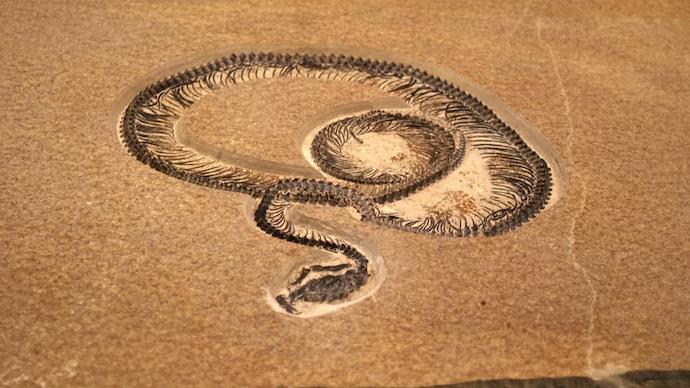Vasuki Indicus

- 20 Apr 2024
Why is it in the News?
Fossils recovered from Kutch in Gujarat may have belonged to the spine of one of the largest snakes to have ever lived, according to new research from the Indian Institute of Technology Roorkee.
Highlights of the Vasuki Indicus Discovery:
- A nearly 50-foot-long snake species, one of the longest and largest in recorded history, once existed in the Indian subcontinent.
- The reptile, Vasuki indicus, lived in India nearly 47 million years ago, fossil remains found from Gujarat’s Panandhro Lignite Mine in Kutch suggest.
- This giant snake, named Vasuki indicus, is estimated to have reached 15 meters in length, exceeding even a T-Rex.
- Scientists found 27 vertebrae, some even in their original position within the spine. They believe Vasuki resembled a large python and lacked venom.
- The species was given the specific name of Vasuki indicus in acknowledgment of the country of its origin, India.
- Vasuki is revered as the king of the snakes in Hindu mythology and is worshiped on special days like Nag Panchami.
About Vasuki Indicus:
- Vasuki indicus belongs to the Madtsoiidae family, and thrived during a “warm geological interval".
- Researchers suggest that the warm tropical temperatures of Gondwanaland, averaging around 28°C, may have contributed to the substantial size and growth of this giant reptile.
- There is a recognized correlation suggesting that higher ambient temperatures can enable larger growth in animals.
- Madtsoiids were also found in Europe and Africa, besides Asia.
- Vasuki indicus represents a large lineage of Madtsoiidae that originated in the Indian subcontinent and then spread to southern Eurasia, before reaching North Africa around 50 million years ago, that’s nearly 15 million years after the dinosaurs went extinct.
- Madtsoiidae, an extinct lineage of terrestrial snakes, thrived on the Indian subcontinent over a span of approximately 100 million years, from the Late Cretaceous to the Late Pleistocene, dating from roughly 98 million to 11,000 years ago.
- During the Late Cretaceous period, the supercontinent Pangea had fragmented into two major landmasses:
- Laurasia, encompassing North America, Europe, and Northern Asia to the north; and
- Gondwanaland to the south, which included present-day Africa, Antarctica, South America, Australia, and the Indian subcontinent.
- The fossils of Vasuki indicus extracted from the early Lutetian grey shale layers of the Naredi Formation at the Kutch mine include an “excellently preserved, partial vertebral column”.
- The discovery sheds light on the biogeographic patterns of dispersion and diversification within the Madtsoiidae, particularly across the Gondwanan continents.
- The presence of this giant snake in the Eocene of India indicates a complex history of faunal exchanges between the Indian subcontinent and other landmasses prior to complete integration into the Eurasian plate.
